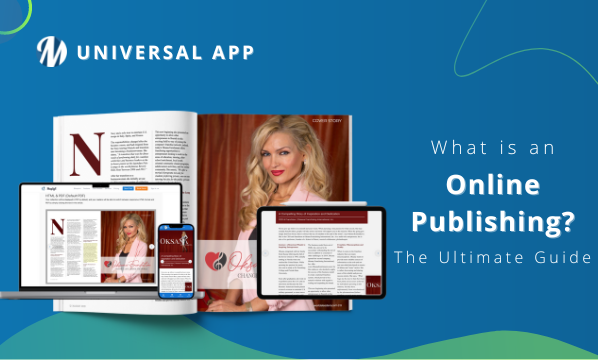Welcome to the ultimate beginner’s guide to digital publishing! In this article, we will cover everything you need to know about digital publishing, including its definition, platforms and software available for use. We’ll also introduce you to some of the top companies in this space and discuss emerging trends in online publishing that are shaping the industry. Whether you’re a marketer or publisher looking to distribute your content online, this guide has got you covered!
What is Digital Publishing?

Digital publishing refers to the creation and distribution of content through digital channels, such as websites, mobile apps, and social media. It differs from traditional publishing in that it eliminates the need for physical copies or printed materials. Instead, digital publishers can offer a range of formats including eBooks, whitepapers, videos and audio books accessible on various devices.
Digital publishing allows reaching a wider audience quickly and cost-effectively compared to print media, with the ability to track reader engagement using analytics tools.
One major benefit of digital publishing is its ability to reach a wider audience quickly and cost-effectively compared to print media. Publishers can also track reader engagement using analytics tools allowing them to refine their marketing strategies accordingly. Marketers can take advantage of this by creating engaging content that resonates with their target audience while increasing brand exposure at the same time.
Difference between Print and Digital Publishing

Digital publishing provides a cost-effective alternative to traditional print publishing. With digital publications, there are no printing or shipping costs, making it an attractive option for publishers and marketers on a budget.
One of the biggest advantages of digital publications is accessibility. Digital platforms offer features like audio and video that can enhance the reader’s experience. Additionally, readers can access digital publications from anywhere in the world using their electronic devices with internet connectivity.
With analytics tools available for measuring engagement with audiences through various metrics like clicks, views and shares; publishers can now understand their audience better than ever before. This data helps them make informed decisions about future content creation strategies to grow brand awareness over time while keeping up-to-date on trends within this fast-moving industry!
Digital Publishing Platform
A digital publishing platform is an online tool that allows publishers to create, manage and distribute their content across various digital channels. It provides a cost-effective solution for companies and professionals who need to reach a broader audience without the high expenses of traditional print publishing. Digital publishing platforms offer various features like drag-and-drop editors, customizable templates, analytics reports which make it easier for businesses to publish engaging content effortlessly. Here is a list of the best digital publishing platforms that we have curated.
How did it work?
Here are some key points about how digital publishing platforms work:
- With tools for creating engaging multimedia content like videos, images, audio files, animations, etc.
- Allow you to customize your design templates according to your brand identity.
- Offer easy-to-use collaboration features that enable multiple users to contribute content simultaneously.
- You can publish your content on multiple channels with just a few clicks
Overall, using a reliable digital publishing platform is an essential strategy for any business wanting to succeed in the modern era of marketing.
Different types of platforms
Web-based platforms for website content management systems (CMS) provide a simple way to create and manage your online content. These platforms offer various features, such as drag-and-drop editors, customizable templates, and easy publishing options. With web-based CMSs, you can easily update your website with new content without the need for technical skills.
Mobile app-based platforms are specialized tools that allow you to design and distribute mobile-friendly digital publications. They usually include interactive elements like audio or video players, slideshows, animations or quizzes that enhance the user experience on small screens. Mobile apps are ideal for creating engaging digital magazines or eBooks specifically designed for phones and tablets.
Desktop software-based platforms enable you to create high-quality eBooks, eMagazines ,and other static documents with advanced page layout features . With desktop software programs like Adobe InDesign or QuarkXPress ,you have full control over every aspect of your publication’s design process from typography to color schemes before exporting it into different digital formats such as PDFs,ePub,Mobi,KF8 etc.
Read more about the different types of digital publishing platforms in our extensive article.
Digital Publishing Software
Digital publishing software is an essential tool for creating and distributing content across digital channels. It allows publishers and marketers to easily design, publish, and distribute their work online. With the right digital publishing technology, you can create engaging publications that are optimized for web and mobile devices.
Here are some of the benefits:
- Easy creation of rich media publications
- Integration with analytics tools for tracking user engagement
- Cost-effective solution in comparison to traditional print methods
- Increased speed in the distribution process
- Ability to publish across multiple platforms including desktops, tablets & mobile devices
Different types of software
Desktop publishing tools are software applications that enable users to design and create documents for print or digital publication. These types of software typically offer advanced formatting options, such as page layout, typography, and image editing features. Examples of desktop publishing tools include Adobe InDesign, QuarkXPress, and Serif PagePlus.
Web-based publishing platforms allow content creators to publish digital content directly on the internet without needing any specialized knowledge in coding or web development. With these platforms, users can easily create websites, blogs, e-books, and other types of online content using drag-and-drop editors. Popular web-based publishing platforms include WordPress.org (self-hosted), Wix.com (hosted), and Squarespace.com (hosted).
Mobile app development tools provide a way for publishers to create interactive mobile apps that can be distributed via app stores like Apple App Store or Google Play Store. These tools typically come with features such as drag-and-drop interface builders that make it easy for non-technical users to build apps without writing code themselves.
Digital Publishing Companies
Digital publishing companies have revolutionized the way content is distributed across digital channels. They offer a range of services including ebook and audiobook production, app development, and web-based publishing solutions.
These companies help publishers reach wider audiences by making their content easily accessible through various online platforms. With more people consuming media on their mobile devices than ever before, partnering with a reputable digital publisher can be an effective way for businesses to stay relevant in today’s fast-paced world.
Examples of Digital Publishing Companies

Digital publishing has become an essential part of modern marketing and content distribution. It refers to the process of creating, editing, and distributing digital content across a variety of platforms, including websites, social media networks, and mobile apps. It enables publishers and marketers to reach wider audiences and engage with them in new and innovative ways.
There are many digital publishing platforms and software available in the market, such as Issuu, Magloft, Joomag, FlipHTML5, and Flipsnack. These companies offer a range of capabilities and services to help publishers and marketers distribute their content across digital channels. They make it easy for businesses to create, edit, and publish content without requiring any technical expertise.
Online Publishing
Online publishing has changed the game for content distribution in recent years. With a few clicks, publishers and marketers can reach millions of readers across various digital channels. The ease and cost-effectiveness of online publishing make it an attractive option for businesses looking to promote their brand through compelling content.
What is Online Publishing?

Online publishing refers to the process of creating and distributing digital content. This can include text, images, audio, video, and other multimedia formats. Unlike traditional publishing methods that rely on physical mediums like books or newspapers, online publishing allows for greater flexibility in terms of format and distribution.
Types of digital content that can be published online:
- Blog posts
- Articles
- E-books
- White papers
- Infographics
- Podcasts
- Videos
The difference between traditional publishing and online publishing lies mainly in the mode of distribution. While traditional publishers often rely on print media to distribute their work, online publishers use websites or social media platforms to reach their audience. Additionally, with online publishing, there is the added benefit of being able to easily track engagement metrics such as page views or shares which can help inform future content decisions.
Benefits of Online Publishing
Digital publishing offers many benefits for companies and professionals looking to promote and distribute their content. With online publishing, you can reach a wider audience through various digital channels, including social media platforms, websites, and email newsletters. This means that your content has the potential to be seen by more people than with traditional printing methods.
Digital Publishing Trends
When it comes to digital publishing trends, interactive content is king. Readers want to engage with the content they consume and interactivity allows for a more immersive experience. This includes quizzes, polls, animations, and other elements that encourage participation. Additionally, video content continues to dominate as a popular form of media consumption online. Publishers need to include videos in their digital strategy if they want to attract and retain readers.
Mobile optimization is also a must for publishers in 2023. With more people accessing the internet through mobile devices than ever before, websites need to be optimized for smaller screens and faster load times on mobile networks. A lack of optimization can result in high bounce rates from visitors who find it difficult or frustrating to navigate your site on their phone or tablet. Overall, keeping up with these trends will help publishers stay relevant and competitive in today’s increasingly digital landscape.
If you are looking for some digital publishing examples have a look at our list of the best digital magazines here.
Future of Digital Publishing
As digital publishing continues to evolve, personalized experiences will become increasingly important. With the help of AI, publishers can tailor content to individual readers based on their preferences and behavior. This not only enhances the reader experience but also improves engagement and drives revenue.
In addition, virtual and augmented reality may become more prevalent in digital publishing. These technologies allow for immersive storytelling that takes readers beyond the confines of traditional text-based content. As VR/AR becomes more accessible and affordable, we can expect to see a rise in its use within the industry.
